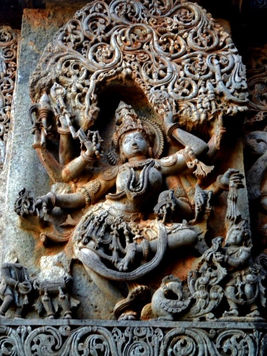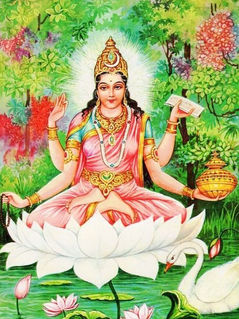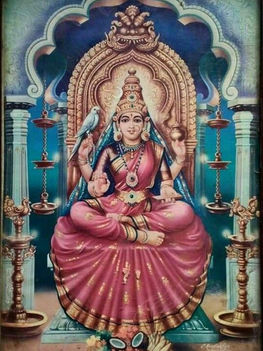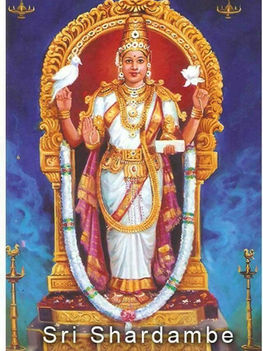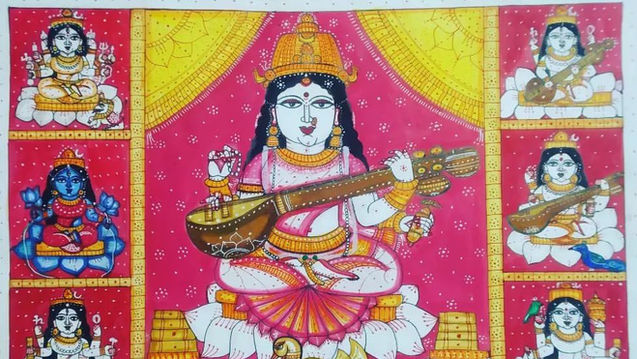
Saraswati
The Goddess of Knowledge, Arts, and Wisdom
Saraswati is the goddess of knowledge, arts, and culture. She is portrayed as a beautiful woman with a white complexion dressed in white clothes and seated on a white lotus, a symbol of great knowledge.
Saraswati's beginnings can be found in the ancient Rigveda, where she is revered as a river goddess connected to wisdom and creative inspiration. She developed into a well-known Hindu divinity over time, revered for her assistance in directing people towards knowledge and enlightenment. She is held in high esteem as a source of knowledge, creativity, and artistic expression, and she has a significant influence on Hinduism's cultural and spiritual environment.
Saraswati is regarded as the consort of Lord Brahma, the universe's creator. Together, they stand for the fusion of inventive intelligence and the capacity to birth fresh concepts and artistic manifestations.
Iconography
Generally, Saraswati is shown with four arms, holding a book, a rosary, a water pot, and a musical instrument called Veena but there are many other depictions of her. Padma Purana depicts her with two arms holding a white lotus and deer horn. The Shilparatna, a classical text on traditional performing arts of South India, describes her with ten arms holding a veena, chakra, conch, skull, noose, battle-axe, Sudha-Kumbha, book, rosary, and a Padma.
A rare depiction of Saraswati from Bengal, Pala school, shows her with the ram as her vahana. It may be related to her Vedic rituals when the rams were sacrificed to her. She is also shown near a river in artwork which creates a link to her early history. In Halebidu Temple, Karnataka, Saraswati is presented under a tree performing a dance, called Natya Saraswati. She represents the three Vidyas, which are natya, yoga, and naada vidya.
Forms of Saraswati
Saraswati is known to manifest in a variety of forms, as are many other prominent deities in Hindu traditions. While Saraswati is frequently depicted as a graceful goddess associated with the realms of creativity, music, learning, and wisdom, she also takes on fierce forms, emphasising her role as a protective deity.
The existence of both gentle and fierce forms of Saraswati in Hindu literature shows the divine feminine's dynamic nature. It emphasises that Saraswati's wisdom and artistic expression can take on various dimensions to both nurturing and protects the cosmic order's balance.
Vac
Vac represents speech and creative expression. She inspires poets, scholars, and artists, allowing them to express their thoughts and emotions. Vac connects gods and mortals by transmitting knowledge and divine truths. She is associated with the sacred sound "Om." She is frequently depicted as a two-armed woman holding a pen and a manuscript. Her characteristics were absorbed into the concept of Saraswati during the Puranic period.
Astha Vac Devis
There are eight forms of Vac Devi, according to the Srikula tradition of Shaktism. These eight goddesses are the epitome of speech, and they wrote the Sahasranama, a type of stotra literature. These forms of the goddesses are also said to reside in the 7th Avarana of the Sri Chakra. These are the goddesses:
-
Vasini
-
Aruna
-
Kameshwari
-
Koulini
-
Jayini
-
Modini
-
Vimala
-
Sarveshwari
Gayatri and Savitri
In some traditions, Saraswati is shown with her two other personalities, Savitri and Gayatri. Savitri is frequently associated with Savitr, a solar deity in the Vedas. Savitri embodies the life force energy. She is depicted with a golden complexion and holding a lotus, a book, a rosary, and a water pot (Kundika). Her mount is a swan. Worship of Savitri is primarily conducted through breathing techniques involving the nostrils.
Gayatri is the personified form of Gayatri Mantra, a hymn in Veda. She is also called Vedamata, the mother of the Vedas. She is stated to be a form of Saraswati but some Puranic literature states Gayatri as distinct from Saraswati. She was a cow herder who helped Brahma in a Yajna in Pushkar and she married Brahma as his second wife. Saivite literature identifies her as a form of Shakti and the consort of Shiva, in his Sadasiva, who has five heads and ten hands similar to the depiction of Gayatri.
Gayatri is shown with five faces, looking in eight directions plus the earth and sky, and ten hands holding, a sword, lotus, trident, disc, skull, goad, noose, a manuscript, jar, Varada mudra in left and Abhaya mudra in right. Her mount is either Swan or Nandi. In recent art, she is shown with two arms sitting on a swan holding a book and Kamandalu, a water pot. She also has a fearsome three-faced form where her two faces with tongue hanging from her mouth. As mentioned in Varaha Purana and Mahabharata, Gayatri also turned into a fierce goddess who slew a demon, Vetravati.
(Read: Consorts of Brahma)
Sharada
Sharada is a form of Saraswati or Parvati, that was historically worshipped in Kashmir, Pakistan. She is the goddess of learning, and it is said that on the ninth day of the seventh month of the year, Ashwin, which falls in Sharada (autumn), she enlightened other deities, earning her the name Sharada. She appears as a fierce goddess with three eyes and six arms. She carries Shakti (weapon), a bow, an arrow, a bell, a pot of gemstones, and a pot of nectar. She sits on a lion. The goddess is also said to be a manifestation of Goddess Parvati.
She is depicted with four hands in a Kashmiri idol and wearing a distinctive Kashmiri-style dress. She holding an upright sword in one hand and the severed head of a goat in the other. Her two lower hands rest on the shoulders of two smaller male figures, each holding a manuscript and possibly representing knowledge (vidya) and wisdom (jnana).
In Sringeri Matha, Karnataka, there is a renowned temple dedicated to Goddess Sharada. The temple is said to have been founded by Vedic scholar Sri Adi Shankaracharya. The goddess is depicted with four arms and a white complexion. She is exquisitely beautiful and is shown sitting on a lotus. She holds a lute (Veena), a book, a rosary, and one hand in blessing posture in her four hands.
Nilasaraswati and Matangi
Nilasaraswati is a fierce form of Saraswati that is commonly associated with Mahavidya's Goddess Tara. She is also thought to be a manifestation of Goddess Matangi, another Mahavidya goddess who represents knowledge and wisdom. In various Dhyana (meditative works of literature) Nilasaraswati is described as having a dark blue complexion, holding a trident, asi (sword), severed head, and bell in her four arms, and is killing Mahishasura, a demon.
(Read: Mahavidya)
Saptasaraswati
Saptasarsawati or Saraswati in a group of seven forms can be found in different traditions. The Meru Tantra is an important Tantric scripture that emphasizes the worship of the celestial Mother and like many other Tantric writings, emphasizes guru-disciple relationships, initiation, and the transmission of esoteric knowledge through an unbroken tradition. The tantra also mentions Saraswati's seven different forms. They are:
-
Maha Saraswati: She appears from Parvati, wearing white, having three eyes, and fair skin. She sits on a white lotus or a lion and has eight hands, each holding a conch, disc, mace, plough, trident, bell, bow, and arrow. Demons like Shumbh, Nishumbh, Raktabeej, and Dhumralochan were defeated by her.
-
Neel Saraswati: She sits on a blue lotus, wears a red saree, and holds two blue lotuses in each hand in Abhaya and Varada mudra.
-
Chintamani Saraswati: She has a fair complexion and sits on a white lotus, wearing white with a crescent moon on her head. She carries a goad, a noose, a book, and a pen.
-
Gyana Saraswati: She is fair and dressed in white, with a crescent moon atop her head. She sits on a white lotus with a swan as her mount, holding a crystal rosary, pen, Vedas, and veena.
-
Kini Saraswati: She holds a goad, noose, and veena, and has three eyes.
-
Ghata Saraswati: She has a rosary, Vedas, and veena in her three hands and one hand in Abhaya Mudra, as well as three eyes and a peacock as her mount.
-
Antariksha Saraswati: She is clad in white and sits on a white lotus. She is holding a crystal rosary, a nectar pail, and the Vedas, with one hand in Abhaya mudra. A bird eats on her rosary, thinking it for pomegranate seeds.
Other notable forms of Saraswati counted as Saptasaraswati are Vakvadhini, Dhee, Gayatri, Swara, Akshara, Bharati, and Bhadrakalai, associated with happiness, concentration, Mantra Siddhi, speech, alphabets, creativity and calculation, respectively.
Ashtasaraswati
In some tantra traditions, like Brahmanda Tantra, and Kamadhenu Tantra, the goddess Saraswati is worshipped in eight forms, called Ashtasarswati. The following are eight recognized forms of Saraswati:
-
Vidya Saraswati: Vidya is a Sanskrit term that means "knowledge." The goddess is the source of knowledge. Vedavyasa, a sage, was able to compose the eight Puranas because of Vidya Sarasvat's blessings. Her iconography depicts her as having fair skin. Her hair is tangled in a jamukua and she is dressed in white. She carries a pair of books representing Vedas and other religious literature, an axe, and a rosary in each of her four arms.
-
Mahavijaya Saraswati: The word Vijaya means victory, hence this form of the goddess is associated with achievement and success. Her iconography depicts her as having a golden complexion. She is dressed in crimson and sits on a red/pink lotus. Her mount is a swan. She has six arms and displays the abhaya mudra while holding a lotus, conch, flag, sword, and lute.
-
Aadya Saraswati: Aadya is the Sanskrit word for "Primordial," referring to Saraswati as the primordial mother goddess. Her iconography depicts her as having a white complexion and eight arms, each holding a noose, goad, book, lute, lotus, sugarcane, and the other hands showing abhaya and vara mudra. The Tridev always worship her lotus feet.
-
Siddha Saraswati: This goddess's form is associated with advanced physical and spiritual development. She is worshipped my Devatas. She has a red complexion and twelve arms, which she uses to hold a disc, conch, sugarcane, mace, arrow, lotus, sword, trident, book, and pitcher, as well as abhaya and vara mudra. She has three eyes, and a crescent moon rests on her forehead.
-
Hamseswari Saraswati: According to her iconography, she has a yellow complexion and rides a swan-pulled chariot. She has three eyes and four hands. She holds a pitcher, a lute, the reign of the chariot, and the Abhaya mudra in her hands. Her brow is adorned with a crescent moon.
-
Vira Saraswati: She is one of Saraswati's furious forms, and she brings luck in every battle. She has four arms, each holding a bow, an arrow, a sword, and a conch. She has a third eye and a crescent moon on her brow.
-
Vaidya Saraswati: She is the Ayurvedic goddess, and Asvini Kumaras worship her lotus feet. Her iconography depicts her as having a white complexion, dressed in green clothing, and adorned with green jewellery. She has three eyes and four arms, holding a rosary, a book, and a pot, while the other displays the abhaya mudra. Her mount is a swan.
-
Putradayini Saraswati: She is who bestows offspring. She has a white complexion and wears a nagamukuta. She possesses six arms and holds a sword, shield, and two lotuses containing the moon and Sun, while the other hand holds a baby.
In Sharada Tilakam Tantra, eight forms of Saraswati are Vagishwari, Hamsa Vageshwari, Vagisi, Soubhagaya Vagheswhwari, Panchavaktra Sharada, Bhutalipi, Varneshwari, and Savitri.
Dwadash Saraswati
Twelve forms of Saraswati are mentioned in Vastu Vidya Diparnava. They are:
-
Jaya Saraswati
-
Vijaya Saraswati
-
Sarangi Saraswati
-
Tumburi Saraswati
-
Kamala Saraswati
-
Naradhi Saraswati
-
Vimala Saraswati
-
Sarva Mangala Saraswati
-
Soumya Saraswati
-
Vidya Dhari Saraswati
-
Sarva Vidya Saraswati
-
Sharada Saraswati
Forms of Saraswati in Thiruvaduthurai matha
Thiruvaduthurai Matha, a Saiva monastery, mentions fifteen forms of Saraswati. They:
-
Saraswati: She is depicted with four hands carrying a manuscript, rosary, kalasha, and lower right hand displaying Gyana Mudra. She is seated on a lotus in Siddhasana, on a lotus.
-
Bhrami: She is one of the Matrika goddesses depicted with four heads and six hands carrying Ankusha, Panchajanya, a manuscript, and a spoon*, and two hands in Abhaya and Varada Mudra. She is seated on a lotus in Lalitasana.
-
Raj Matangi: She is depicted with eight hands carrying a lotus, cane, Ankusha, Panchajanya, and parrots in two hands and the remaining two hands holding a veena. She is seated on a lotus in Lalitasana.
-
Thenu Vaheshwari: She is depicted with four hands carrying Ankusha, Panchajanya, manuscript, and rosary. She is seated on a lotus in Lalitasana.
-
Vidhya: She is depicted seated in Lalitasana on a serpent with five heads, she has matted hair and two hands carrying a veena.
-
Sutha Vidhya: She is depicted with four hands carrying a manuscript, and rosary, and two right hands in Gyan and Abhaya Mudra. She is seated on a lotus in Padmasana.
-
Vaspathi: She is depicted with four hands carrying a manuscript, a rosary, and the upper two hands carrying lotuses. She is seated on a lotus in Lalitasana and four sages are depicted honoring her.
-
Jana Saraswati: She is depicted with four hands carrying manuscripts in her upper two hands, and the lower hands carrying a lotus and a bouquet with a parrot seated on it. She is seated on a lotus in Lalitasana.
-
Vaheshwari: She is depicted with four hands carrying a manuscript and rosary in her upper two hands, and the lower two hands in abhaya and varada mudra. She is seated on a lotus in Siddhasana, on a lotus.
-
Gayathri: She is depicted with five heads and ten hands carrying various attributes.
-
Maha Vidya: She is depicted with four hands carrying a manuscript, lotus, oil lamp, and veena. She is seated on a lotus in Lalitasana and four sages are depicted honoring her.
-
Mahasaraswati: She has eight hands carrying an arrow, bow, trident, plough, cane stick, chakra, bell, and Panchajanya. She is seated on a lotus in Lalitasana on a lotus.
-
Sarada: She has ten hands carrying a lotus, square plate*, kalasha, chakra, noose, sword, bowl, and manuscript, and the remaining two hands in abhaya and varada mudra. She is seated on a lotus in Lalitasana on a pedestal.
-
Kameshwari: She is depicted with four hands carrying a manuscript, rosary, veena and kamandalu. She is seated on a pedestal in Lalitasana.
-
Neel Saraswati: She is depicted with four hands carrying a trident, bowl, skull and upper right hand in suchi mudra. She is seated on a pedestal in Lalitasana.
*There isn't enough information about these forms since Matha's books aren't publicly available.


